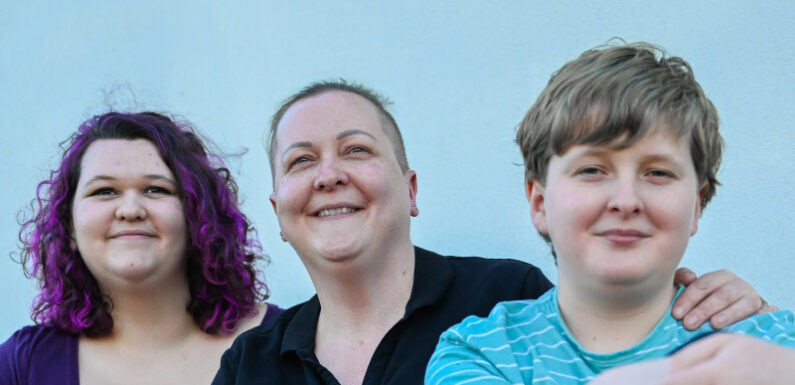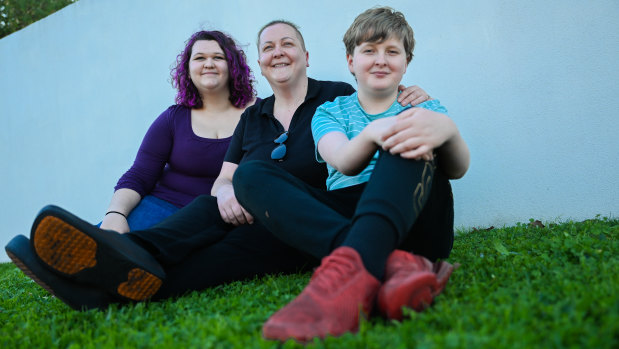
Save articles for later
Add articles to your saved list and come back to them any time.
When schools reopened after lockdown, East Bentleigh mother Rebecca Dell’s children felt it was no longer safe to go back to the classroom.
There were traumatic mornings of tears and tantrums – three of her four children experienced school refusal.
“Anxiety is a very real thing,” she said.
Rebecca Dell with two of her four children; Ash Dell, 17, and Antal Kiss, 12. Credit: Joe Armao
The siblings are part of a rising national trend which has been highlighted by a Senate inquiry into school refusal and related matters, launched in October last year.
The inquiry – which received more than 170 submissions – found there had been a decline in attendance rates nationally between 2021 and 2022 for years 1 to 10. It dropped from 90.9 per cent to 86.5 per cent in that year, with the proportion of full-time students whose attendance was equal to or greater than 90 per cent dropping from 71.2 per cent to 49.9 per cent.
The Australian Curriculum, Assessment and Reporting Authority said the decline could be due to the COVID-19 Omicron-variant, a high flu season and flooding in parts of the state.
But organisations have said it’s also due to school refusal.
Virtual School Victoria, a state school, enrolled 895 students last year who had been referred by medical practitioners due to school refusal. Due to a lack of national data on school refusal, and variation in how different education authorities record it, it’s hard to know how dire the issue is.
“We found all of our kids lost their confidence and ability to deal with peers, where things were bad before the lockdown they became 10-times worse upon returning to school,” Dell said.
Even on the days she did get her kids to school, some would arrive in tears, visibly upset and needing support from a teacher or wellbeing officer.
The report, released on Thursday, recommended education ministers develop a national action plan to tackle school refusal, to be undertaken by the Australian Education and Research Organisation over 12 months, and for the development of a nationally accepted definition of school refusal, as well as a nationally consistent way of recording the reasons for absences.
The committee also recommended schools offer more flexible options for students struggling with school refusal and that the federal government work with state and territory governments to improve awareness and understanding of school refusal. It called for a focus on psychiatry, psychology and general practice, as well as increasing subsidised mental health care visits for students experiencing school refusal.
Other recommendations included reviewing child health and development screening programs to improve early identification of autism, ADHD and other specific learning and anxiety disorders to help with classroom support.
School Refusal Clinic’s John Chellew welcomed the recommendations, saying they highlighted the importance of increasing mental health care for students with school refusal.
“The current state of mental health care access for students demands urgent attention,” he said.
Chellew also said trauma-informed practices at schools and strengthening family engagement was important, as was addressing challenges around formal disability diagnoses.
“The early identification of students at risk of school refusal is proactive measure that cannot be underestimated,” he said. “Data collection, especially around school absence, is crucial.”
For Dell’s children, moving to Alia College, an alternative independent school in Hawthorn East, has had a profound impact.
Ash, 17, and Antal, 12, both go there, and they like it so much her 11-year-old daughter Rosie is earmarked to go there as well.
Dell said the school had smaller enrolments, and catered more to individual students. It meant Ash’s grades, which were previously slipping, are now up again.
She welcomed the recommendations and said a focus on early screening programs was important, especially for her children.
“My youngest child is a COVID preppie, who to-date has not had a ‘normal’ day at school. We were fortunate that early signs of [autism spectrum disorder] arose in kindergarten,” she said.
“I think school is a really important part of diagnosing. [Teachers] see 26 students in a classroom and they can see 23 are the norm. Early intervention is key.”
She also said recording school refusal, as opposed to truancy or illness in attendance, was another key recommendation she hoped would be adopted.
“Something that prompts or raises a flag with the wellbeing officer or classroom teacher or coordinator to touch base and make contact with the parent. ‘How can we support them? We need to arrange a meeting and let’s follow this up’.”
But she worries about the kids who slip through the cracks – and those who can’t get mental health support.
“What it’s going to mean in terms of their education… when they’re spat out the other side of it – having a child drop out at year 10?”
Get the day’s breaking news, entertainment ideas and a long read to enjoy. Sign up to receive our Evening Edition newsletter here.
Most Viewed in National
From our partners
Source: Read Full Article
